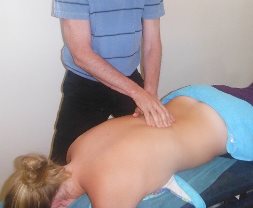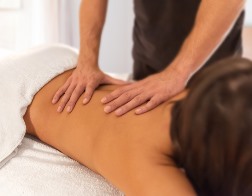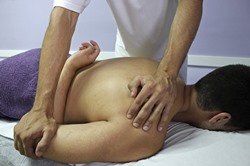What is Therapeutic Massage?
 As mentioned in the introduction, therapeutic massage is a holistic form of healthcare that helps people feel and function better. The massage therapist manipulates muscles, tissue and skin to reduce stress and relieve tension and pain in their clients. Swedish, or Classic Massage, is the kind of massage that most of us relate to when discussing therapeutic massage, and almost all Magna UT massage therapy schools offer it as their primary type of massage. However, there are many other forms of massage that programs may or may not include within their course of instruction. Following are just a few examples.
As mentioned in the introduction, therapeutic massage is a holistic form of healthcare that helps people feel and function better. The massage therapist manipulates muscles, tissue and skin to reduce stress and relieve tension and pain in their clients. Swedish, or Classic Massage, is the kind of massage that most of us relate to when discussing therapeutic massage, and almost all Magna UT massage therapy schools offer it as their primary type of massage. However, there are many other forms of massage that programs may or may not include within their course of instruction. Following are just a few examples.
- Neuromuscular Therapy Massage
- Deep Tissue Massage
- Sports Massage
- Shiatsu Massage
- Thai Massage
- Hot Stone Massage
- Pregnancy Massage
Professionals that work in therapeutic massage should be referred to as massage therapists. From time to time one may hear them called a masseuse or a masseur, which refers to a female or a male massage practitioner. However, these terms typically have a negative connotation among the general public and Magna UT professionals alike and should be avoided.
Massage Therapist Education Requirements
 Almost all Magna UT massage therapy programs require that the enrollee has earned a high school diploma or its equivalent to qualify. Programs can vary in length from several months for a Certificate or a Diploma to as long as two years for an Associate’s Degree. The lengths of the programs will also vary by State based on the training hours required for licensing. Another factor that can also have an effect on the length of the program is whether classes are scheduled during the daytime or in the evening. In addition, an Associate Degree in Massage Therapy may have general education requirements and the credits may be transferrable into a similar Bachelor’s Degree Program. After you have received your Degree, Diploma or Certificate, the education does not end there. The amount and type of continuing education you will need to complete will depend on the State where you are licensed. Some states require both a certain number of hours of continuing education as well as specific education in subjects, such as HIPPA compliance or ethics.
Almost all Magna UT massage therapy programs require that the enrollee has earned a high school diploma or its equivalent to qualify. Programs can vary in length from several months for a Certificate or a Diploma to as long as two years for an Associate’s Degree. The lengths of the programs will also vary by State based on the training hours required for licensing. Another factor that can also have an effect on the length of the program is whether classes are scheduled during the daytime or in the evening. In addition, an Associate Degree in Massage Therapy may have general education requirements and the credits may be transferrable into a similar Bachelor’s Degree Program. After you have received your Degree, Diploma or Certificate, the education does not end there. The amount and type of continuing education you will need to complete will depend on the State where you are licensed. Some states require both a certain number of hours of continuing education as well as specific education in subjects, such as HIPPA compliance or ethics.
Massage Therapy Licensing
 Once you have graduated from an accredited Magna UT massage therapy program, the next step is to obtain your license in the State where you will be practicing. The Massage & Bodywork Licensing Examination (MBLEx), is an exam controlled and administered by the Federation of State Massage Therapy Boards (FSMTB) and is required by the majority of States as part of the licensing process. Some States have additional tests or their own, so check with your State prior to enrolling in a massage therapy program. If you fail the MBLEx in the first attempt, you can take it again after 30 days but will be charged another testing fee. Once licensed, you will be required to maintain it in most states, which means paying a renewal fee and satisfying renewal requirements. As previously stated, renewal typically requires a certain number of hours of continuing education be completed. And if you should move to another State, you will need to get licensed in that new State also. Each State has different regulations for massage therapists, so it is not safe to assume that you will automatically qualify for licensing. Check with your new State before moving to confirm that you have satisfied the requirements to practice legally there.
Once you have graduated from an accredited Magna UT massage therapy program, the next step is to obtain your license in the State where you will be practicing. The Massage & Bodywork Licensing Examination (MBLEx), is an exam controlled and administered by the Federation of State Massage Therapy Boards (FSMTB) and is required by the majority of States as part of the licensing process. Some States have additional tests or their own, so check with your State prior to enrolling in a massage therapy program. If you fail the MBLEx in the first attempt, you can take it again after 30 days but will be charged another testing fee. Once licensed, you will be required to maintain it in most states, which means paying a renewal fee and satisfying renewal requirements. As previously stated, renewal typically requires a certain number of hours of continuing education be completed. And if you should move to another State, you will need to get licensed in that new State also. Each State has different regulations for massage therapists, so it is not safe to assume that you will automatically qualify for licensing. Check with your new State before moving to confirm that you have satisfied the requirements to practice legally there.
